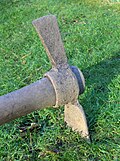Mattock

A mattock is a versatile hand tool, used for digging and chopping, similar to the pickaxe. It has a long handle and a stout head, which combines an axe blade with a pick end. Mattocks are known for their effectiveness in breaking up hard soil and rock, as well as for their use in chopping roots and other materials.
History[edit]
The mattock is an ancient tool, with its use dating back thousands of years. It has been a fundamental instrument for agriculture, construction, and warfare throughout human history. Early mattocks were made of wood, stone, and later, metal, as human technology advanced. The tool has evolved over time but has maintained its basic form and function. In many cultures, the mattock was a symbol of labor and was often associated with farming and rural life.
Design[edit]
A typical mattock consists of a handle and a head. The handle is usually made of wood or fiberglass, designed to absorb shock and reduce user fatigue. The head is made of metal, with one end being flat and broad (similar to an axe) for cutting and chopping, and the other end being pointed or narrow (similar to a pick) for digging and breaking up soil or rock. The weight of the head can vary, but it is typically balanced to provide effective swing and impact.
Types[edit]
There are several types of mattocks, each designed for specific tasks:
- The cutter mattock has a cutting edge on one side and a horizontal adze on the other. It is primarily used for cutting through roots and clearing vegetation.
- The pick mattock combines a pick on one side with an adze or axe on the other. It is effective for breaking up hard ground and rocks.
- The grubbing mattock is similar to the cutter mattock but has a narrower adze. It is used for digging and grubbing in soil.
Uses[edit]
Mattocks are used in a variety of tasks, including:
- Agriculture: for preparing and breaking up soil, planting, and harvesting root crops.
- Construction: for excavating, trenching, and demolition work.
- Landscaping: for removing stumps, roots, and clearing brush.
- Archaeology: for careful excavation and soil removal.
Maintenance[edit]
Proper maintenance of a mattock includes regular cleaning, sharpening of the cutting edge, and checking the handle for cracks or wear. A well-maintained mattock can last for many years, even with frequent use.
Safety[edit]
When using a mattock, it is important to wear appropriate safety gear, including gloves and eye protection. The tool should be used with caution, as its sharp edges and heavy head can cause injury if mishandled.
In Popular Culture[edit]
The mattock has appeared in various myths, legends, and stories, often symbolizing hard work, agriculture, and the rural lifestyle. It remains a powerful symbol of human labor and ingenuity.
-
Cutter mattock
-
Mattocking
Ad. Transform your life with W8MD's Budget GLP-1 injections from $75


W8MD offers a medical weight loss program to lose weight in Philadelphia. Our physician-supervised medical weight loss provides:
- Weight loss injections in NYC (generic and brand names):
- Zepbound / Mounjaro, Wegovy / Ozempic, Saxenda
- Most insurances accepted or discounted self-pay rates. We will obtain insurance prior authorizations if needed.
- Generic GLP1 weight loss injections from $75 for the starting dose.
- Also offer prescription weight loss medications including Phentermine, Qsymia, Diethylpropion, Contrave etc.
NYC weight loss doctor appointmentsNYC weight loss doctor appointments
Start your NYC weight loss journey today at our NYC medical weight loss and Philadelphia medical weight loss clinics.
- Call 718-946-5500 to lose weight in NYC or for medical weight loss in Philadelphia 215-676-2334.
- Tags:NYC medical weight loss, Philadelphia lose weight Zepbound NYC, Budget GLP1 weight loss injections, Wegovy Philadelphia, Wegovy NYC, Philadelphia medical weight loss, Brookly weight loss and Wegovy NYC
|
WikiMD's Wellness Encyclopedia |
| Let Food Be Thy Medicine Medicine Thy Food - Hippocrates |
Medical Disclaimer: WikiMD is not a substitute for professional medical advice. The information on WikiMD is provided as an information resource only, may be incorrect, outdated or misleading, and is not to be used or relied on for any diagnostic or treatment purposes. Please consult your health care provider before making any healthcare decisions or for guidance about a specific medical condition. WikiMD expressly disclaims responsibility, and shall have no liability, for any damages, loss, injury, or liability whatsoever suffered as a result of your reliance on the information contained in this site. By visiting this site you agree to the foregoing terms and conditions, which may from time to time be changed or supplemented by WikiMD. If you do not agree to the foregoing terms and conditions, you should not enter or use this site. See full disclaimer.
Credits:Most images are courtesy of Wikimedia commons, and templates, categories Wikipedia, licensed under CC BY SA or similar.
Translate this page: - East Asian
中文,
日本,
한국어,
South Asian
हिन्दी,
தமிழ்,
తెలుగు,
Urdu,
ಕನ್ನಡ,
Southeast Asian
Indonesian,
Vietnamese,
Thai,
မြန်မာဘာသာ,
বাংলা
European
español,
Deutsch,
français,
Greek,
português do Brasil,
polski,
română,
русский,
Nederlands,
norsk,
svenska,
suomi,
Italian
Middle Eastern & African
عربى,
Turkish,
Persian,
Hebrew,
Afrikaans,
isiZulu,
Kiswahili,
Other
Bulgarian,
Hungarian,
Czech,
Swedish,
മലയാളം,
मराठी,
ਪੰਜਾਬੀ,
ગુજરાતી,
Portuguese,
Ukrainian


